|
Tolman
Pond
Nelson,
NH
Mid-1930's-Late 1940's
(Rope Tow Served)
1970's-1980's (Bombardier Served)
Still skied by family/locals today (non-lift served) |
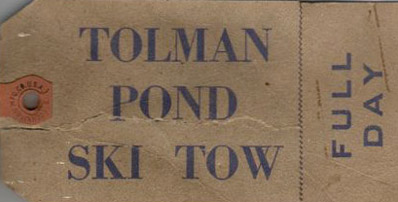 |
History ~
Historic
Photos ~ Recent Photos ~ Memories
History
Many thanks to Karen Tolman who wrote the following history of this ski area,
and sent us extensive historic and recent photos of the ski area. All pictures
are courtesy of her, please click on each for the larger version.
ON THE SKI HILL AT TOLMAN POND
Karen Tolman, 2011
|
I’ve just lugged a couple of green
plastic chairs up to the top of the Jack Rabbit, a hill overlooking
Tolman Pond and the 1790's vintage Farmhouse, which was cleared for
skiing in the 1920’s - we're told one of the first such hills in New
England.
I sit here, looking out over this little
40-acre gem of water, and wonder what it was like in the early days of
skiing when small ski hills were sprouting up all over the New England
landscape. |
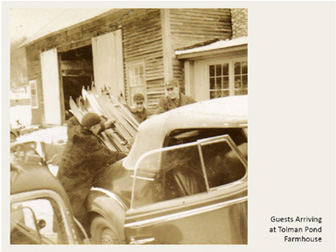 |
|
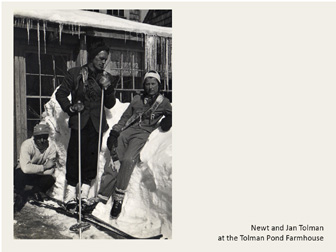 |
Such was the case at
Tolman Pond where brothers Newt and Fran Tolman helped their folks Ma
(Sadie) and Pop (Wayland) run a guesthouse in the old family Farmhouse.
They also rented out ten summer cabins, whose renters usually joined the
others for meals in the Farmhouse. In order to make ends meet a little
bit better, they expanded their winter business by adding something new
- skiing. |
| They not only cleared the
Jack Rabbit in the 1920’s, but also extended the clearing out in all
directions eventually encompassing several acres. They cleared trails up
Hurd Hill behind the Farmhouse, and anywhere else they deemed feasible
for a ski run. They used the field, where Ted Lenk and Susan Weaver now
pasture their sheep, for lessons and practice. This field is still
called the Practice Slope. |
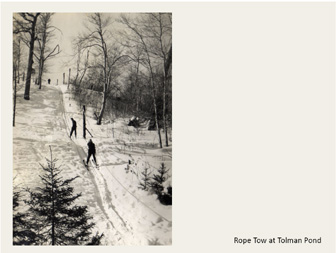 |
|
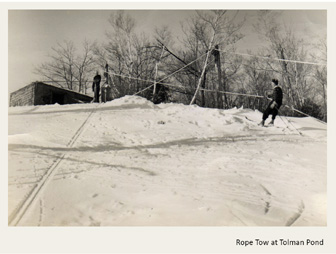 |
Newt set up a shop in the back of the
barn at the Farmhouse to make wooden skis. He not only sold his skis but
also rented them out. During the height of the season, Uncle Bill French
helped to manage the shop where he fitted and waxed the rental skis for
the guests. These were also the days when you had to climb to get to the
top of the hill, so Newt recommended wrapping sealskins around his
handcrafted skis to create some traction while climbing.
|
| His ski-making venture
soon evolved into making double-ended skis. He and his wife then offered
lessons in how to use these for something Newt called "figure skiing".
In fact, Newt later spent some time in Austria studying established
skiing techniques, but came home more dedicated than ever to figure
skiing. |
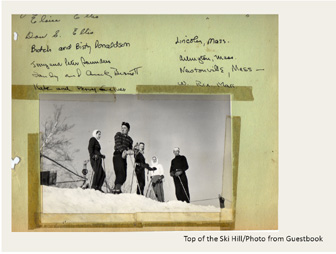 |
|
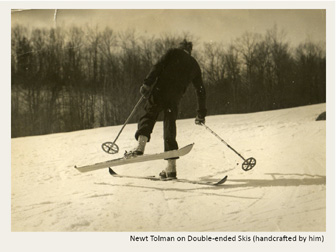 |
During this time, he also
claims to have invented the use of metal edges, a strip of metal that he
tacked onto the edges of the skis to make turning easier while skiing
down the hill. He then carved a couple of "steps" into the bottoms of
his wooden skis to aid in climbing. |
| In a February 1957
article in the Atlantic Monthly, "Schussing a Few Decades", Newt wrote
that: "among my own modest contributions were
metal edges made out of bronze clock springs, a patented ski with a
stepped bottom, and a technique known as "figure skiing." Using
eight-foot double-ended skis, it enabled the skier to approximate
somewhat loosely, much of the repertoire of Sonja Henie." |
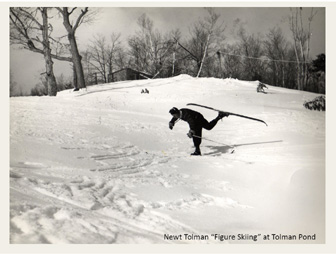 |
|
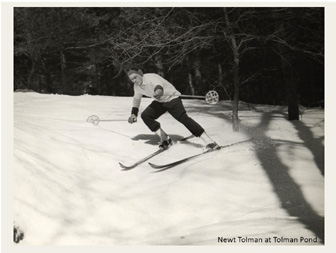 |
Today, there are relics of
Newt’s inventions tucked away in the hayloft at the Farmhouse gathering
dust - double-ended skis, metal edges, stepped bottoms. I think about
these today, sitting up here on the hill - inventions far ahead of their
time. |
| Becoming quite established
as a destination for skiers, and with a growing clientele, many coming
from the Boston area, it was time to turn up the volume and add a rope
tow. |
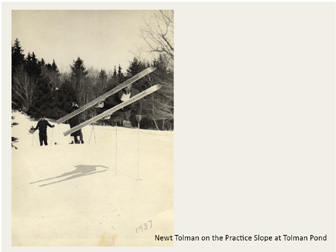 |
|
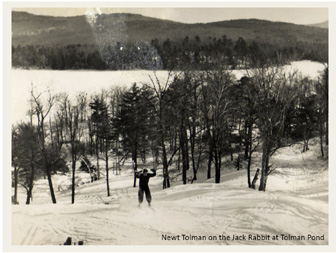 |
From some rapidly
expanding Vermont ski hill, they found a discarded 1931 Model A Ford
engine, packaged with the necessary pulleys, shafts, belts and drive
mechanisms. They were then gifted a well-worn, and no longer used, sisal
rope from the drive that had powered the Cheshire Woolen Mills for many
years in the neighboring town of Harrisville. |
| Together with these
acquisitions, they went to work. In the late 1930’s, having contracted
with friend, neighbor and master mechanic, Walter Hutchins, to operate
the tow, they opened for winter business with the addition of a new rope
tow. Meanwhile, back at the Farmhouse, the chores loomed large. Ma
Tolman, with the help of Mabel Curtis, housed and fed the skiing guests
with reportedly fabulous home-cooked meals. Pop, with the help of Newt
and Fran, kept the wood shed filled, the fires stoked, the cows milked,
the cream separated, the ice-cream bucket churning, the ice cut and
stored for the ice-box, the eggs gathered, the plumbing fixed to
accommodate its new-found demands, the root cellar and canned goods
picked over, the chickens plucked, and the orders sorted from the
Harrisville Store deliveries. |
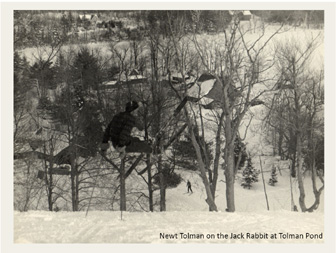 |
|
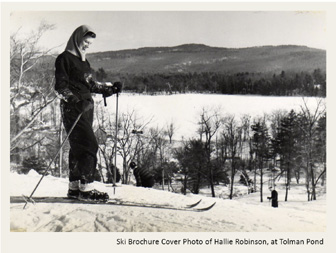 |
In the main part of the
Farmhouse, where Tom Tolman and Larisa Belluscio now live, there were
three double-bedrooms downstairs, two single-bedrooms upstairs, as well
as the Rabbit Warren that could board a few more (heated by a hole
through the floor which welcomed not only heat from below, but the rich
smells from the kitchen), and the GHQ (aka General Headquarters), an
unheated space that bunked many more. We’re told that as many as thirty
skiers could be accommodated here at any given time - serviced by two
rather marginally plumbed bathrooms. |
| The living room and dining
room became the after-ski and after-dinner gathering spot where music
and stories and games were shared around the old upright Steinway piano
and the center-chimney fireplace. Newt and Fran were both skilled
musicians and storytellers. |
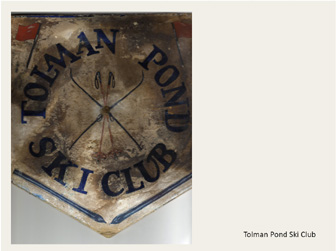 |
|
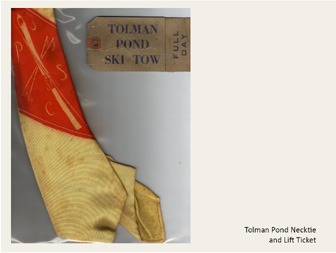 |
The other end of the
house, where the sheds had earlier been converted into living quarters,
was home for Ma and Pop. This area of the Farmhouse became known as the
Ski Room, and is used today by our family and friends. This was where
cold and wet clothing was shed and hung by the fireplace to dry. There
was a ping-pong table in the large open living room, and Priscilla
Walter recently reported that she remembers a swing hanging from the
rafters. The cooking was done over here as well, accessing the dining
room by a swinging door. And, Ma was often found resting in her
adjoining sitting room that she shared with a few cats, a deck of cards,
and gift boxes of nibbled and tasted chocolates. Someone was always
visiting with her there. |
| In fact, when there were
overflow guests in the main part of the house, she and Pop would set up
a bed in this sitting room and offer their own bedroom to the paying
guests. Never knowing what tomorrow might bring, they stacked ‘em in
anywhere they could while the going was good. |
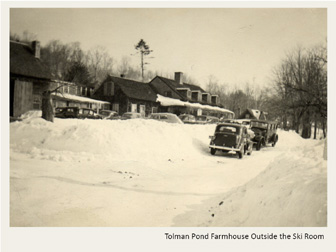 |
|
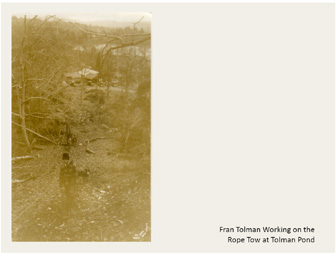 |
Above the Ski Room, there
was a seasonal (then unheated and unplumbed) apartment used by the help
in the summertime, and minimally used in the wintertime by Robert
Curtis, who helped out on the farm. Today, this apartment is home to
Kirk Dale. |
| The ski hill operated into
the mid 1940’s, but by then interest had shifted to the larger and
better-equipped ski areas in New England. But a few years later, Fran's
son Barry, who grew up skiing on the hill, tried to resurrect the tow.
In the late 1940’s, at about 15 years old, he enlisted the help of
friend and neighbor, Frank Upton. But the project was finally abandoned
to the brambles, briars and ferns that eventually took over the hill. |
 |
|
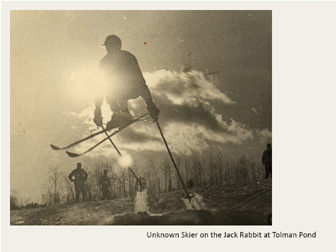 |
But, old dreams die hard.
When Barry had children of his own, he became obsessed with the Ski Hill
once again. By the mid 1970’s, brush was cleared and trails were cut.
And then, from a defunct Claremont radio station: |
|
He bought the Bombardier with Harry and
Bronson*
To haul kids up the Ski Hill to ski down the Jack Rabbit.
It was a deal at five hundred, but it came in pieces,
In a truckload that dumped it all over the bejesus.
With an engine from Frank and shop time from Harvey**,
They rebuilt this thing into a sight far from sorry.
It arches like a rainbow, not knowing its front from its back,
And glides through the snow with the grace of a cat.
Up the hill, over the road, the kids hang on tight
To the railings and rope tow with all their might.
Dropped off at the top, the kids ski down,
Nor daring to stop less they miss the next round.
* 1959 Bombardier snow cat; Harry Suttenfield and Bronson Shonk
** Frank Upton and Harvey Tolman
|
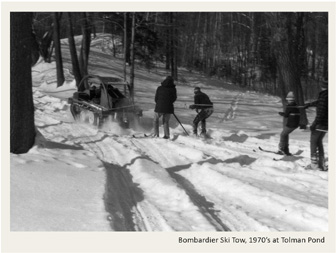 |
|
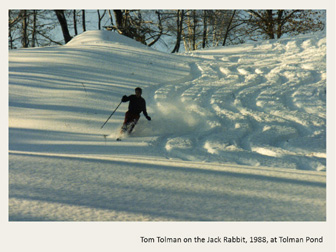 |
So then again, as in earlier days at
Tolman Pond, many neighborhood kids grew up skiing on the Jack Rabbit.
As I sit here up on the hill, I look out
over where the tow once was and where the Bombardier once ran. Perhaps
someday the “Bomber” will be put back to use. Meanwhile, it sits in the
shed behind the Farmhouse needing some fixing.
|
|
Then again, perhaps some other means of
uphill transportation will come along first.
But for today, the kids, even some in
their 20’s and 70’s, don’t mind climbing the hill to get in a few runs
after work and on the week-ends. And, Barry, with his cousin Renn, his
son Tom, his grandson Wayland, many other family members, friends, and
even occasional cows, have kept the hill mowed, so that we can all look
forward to a couple more runs down the Jack Rabbit - schussing into a
few more decades.
|
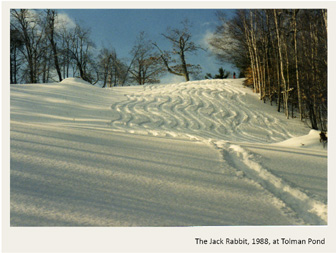 |
Other Historical
Images
|
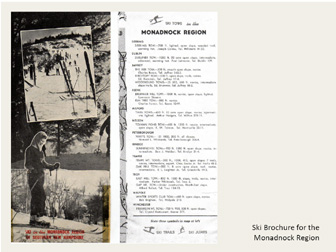 |
Tolman Pond was featured in this
Monadnock Ski Brochure from the 1930's. |
Recent Photos
|
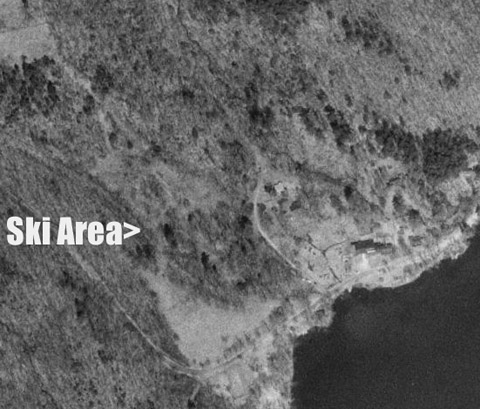
|
This 1998 view of the ski area shows
some of the slopes. |
| While a rope tow no longer
operates, the trails are kept clear with a beautiful view of Tolman
Pond. This is a classic New Hampshire view! This view shows a knoll with
the pond taken in spring of 2009. |
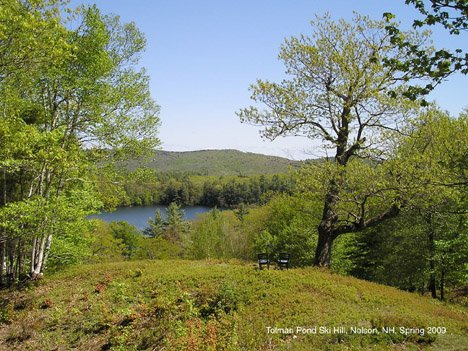 |
|
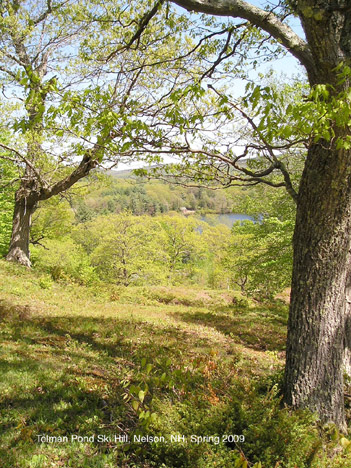 |
Another view of the ski slope and
pond, spring 2009. |
|
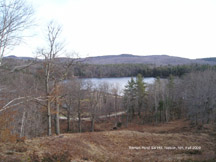 |
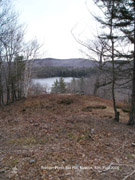 |
| Fall 2009 View. |
Fall 2009 view, similar
to above. |
| Tom Tolman on the Jack Rabbit, 2010,
in deep powder snow. |
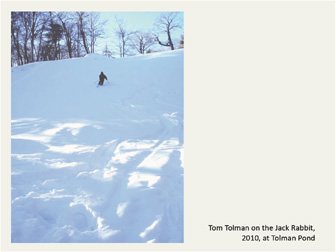 |
Memories
Ned Bolle spoke to John Summers of Summer's
Backcountry Sports in Keene NH about this ski area. Here's what he found:
"We discussed other areas in the region.
Tolman Pond, he is confident, was the first rope tow in the area. He said
it began operating in 1934. (I checked in Newt Tolman's autobiography, North
of Monadnock, but found only a vague reference to a tow. He did
mention operating something of a bed and breakfast, and hosting skiers in the
twenties.)"
Steve
Lindsey has more info: I live at Tolman Pond at the base of this
venerable ski hill. The farmhouse where visitors could stay contains artifacts
from the days of skiing in the early 1930s including an impressive
collection of wood skis, snowshoes, and a hand-painted trail sign. Relatives
of Alpine skiing pioneer Newt Tolman still live in the farmhouse. They have
photos of skiers. John Summers, one of the founders of the nearby Pinnacle
Mountain Ski Hill in Roxbury believes the Tolman Pond site may be the second
oldest, after Vermont's Suicide Six.
The
logging skid which served as the base of Newt Tolman's rope tow engine still
exists, rotting into the earth. The motor has been removed, but a flywheel,
gears, axles, and brackets still are mounted on the skid.
Does anybody else remember
this one?
Head
back to Lost New Hampshire Ski Areas
Head
back to the Main Page
Last updated:
June 22, 2011
